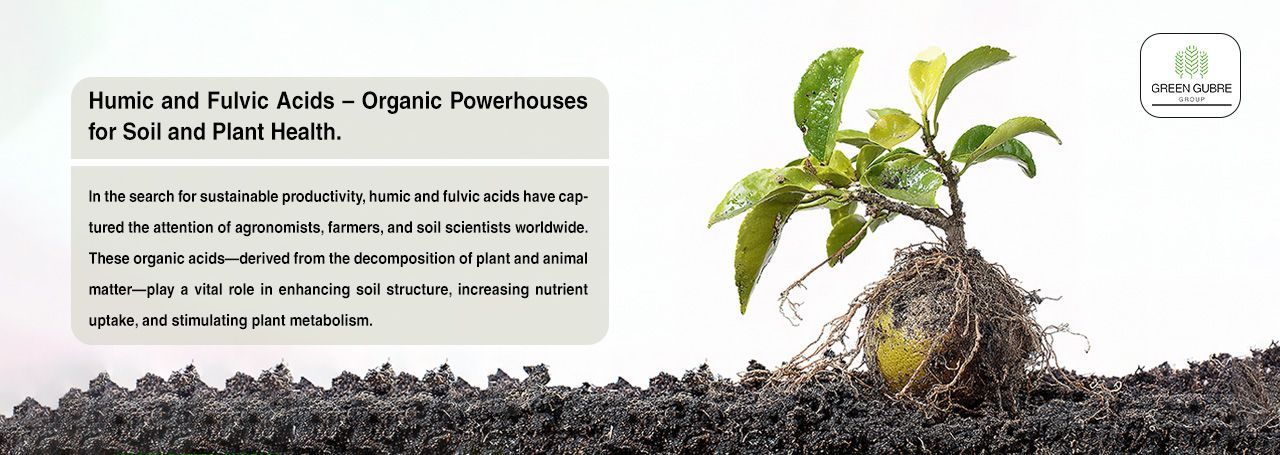Humic and Fulvic Acids – Organic Powerhouses for Soil and Plant Health
Humic and Fulvic Acids – Organic Powerhouses for Soil and Plant Health

Introduction: The Natural Boost Beneath Our Feet
In the search for sustainable productivity, humic and fulvic acids have captured the attention of agronomists, farmers, and soil scientists worldwide. These organic acids—derived from the decomposition of plant and animal matter—play a vital role in enhancing soil structure, increasing nutrient uptake, and stimulating plant metabolism.
Unlike synthetic inputs, humic substances work by improving the soil-plant interface, making nutrients more available while supporting microbial life. The result? Better root growth, improved crop resilience, and a healthier soil ecosystem—all with fewer inputs.
What Are Humic and Fulvic Acids?
Humic Acid
- Larger, more complex molecules
- Improve soil structure and nutrient-holding capacity
- Act as slow-release chelators for minerals
- Most effective in the root zone (soil application)
Fulvic Acid
- Smaller, water-soluble molecules
- Easily absorbed by plants (foliar or soil)
- Actively transport nutrients across cell membranes
- Enhance enzyme activity and photosynthesis
Both substances are naturally present in well-decomposed organic matter, as well as in leonardite, peat, or compost sources.
How They Improve Soil and Crop Performance
| Benefit | Humic Acid | Fulvic Acid |
|---|---|---|
| Improves soil structure | ✅ | - |
| Increases nutrient retention (CEC) | ✅ | - |
| Enhances root development | ✅ | ✅ |
| Stimulates microbial activity | ✅ | ✅ |
| Boosts nutrient uptake | ✅ (indirect) | ✅ (direct) |
| Transports micronutrients into cells | - | ✅ |
| Reduces abiotic stress (salinity, drought) | ✅ | ✅ |
Source – Journal of Plant Nutrition
Applications and Use Cases
Crops:
- Vegetables (tomatoes, cucumbers, lettuce)
- Cereals and grains (wheat, maize)
- Fruits (grapes, berries, citrus)
- Industrial crops (sugarcane, cotton)
- Ornamentals and turfgrass
Application Methods:
- Soil Drench or Fertigation: Apply humic acid at 10–30 kg/ha or 5–10 L/ha (liquid)
- Foliar Spray: Use fulvic acid at 0.1–0.5% concentration
- Seed Treatment: Fulvic acid enhances germination and early vigor
- Compost Activation: Add humic acid to boost compost microbial activity
Tip: Combine with NPK or micronutrient fertilizers to improve uptake and reduce losses.
Role in Nutrient Efficiency and Sustainability
Humic substances are champions of fertilizer use efficiency (FUE):
- Reduce nitrogen leaching and phosphorus fixation
- Improve micronutrient availability (especially Fe, Zn, Mn)
- Support organic farming and regenerative agriculture models.
They also lower input costs over time by reducing the need for excessive fertilization while improving crop quality, shelf life, and tolerance to environmental stress.
Source – FAO – Organic Soil Amendments
Green Gubre Group’s Organic Acid Solutions
We supply high-quality, concentrated humic and fulvic acid products for both conventional and organic farms:
- HumiMax™ Granules: 70–80% humic acid from leonardite, for pre-plant or basal application
- FulviBoost™ Liquid: 12% fulvic acid, compatible with foliar and fertigation systems
- BioBlend™ NPK + Humic Mixes: Combines macro + micronutrients with organic acids
- Compost Activator Packs: For enhancing homemade or commercial composts
All formulations are designed to improve soil health, nutrient mobility, and plant resilience across diverse cropping systems.
Conclusion: Organic Acids for Smart Agriculture
Humic and fulvic acids are not just soil amendments—they are biological catalysts that bridge the gap between conventional inputs and regenerative practices. By boosting soil structure, nutrient uptake, and plant metabolism, they offer a powerful, nature-aligned path to higher yields, better quality, and long-term sustainability.
In an era of rising costs and climate uncertainty, these organic powerhouses are more relevant than ever.




